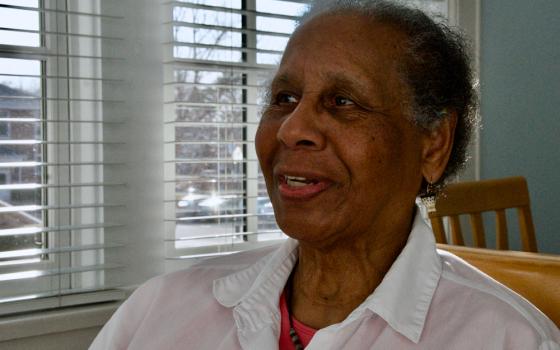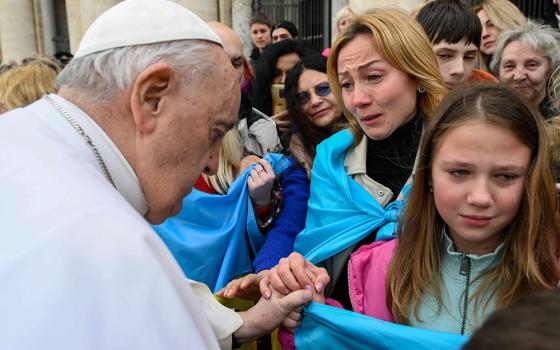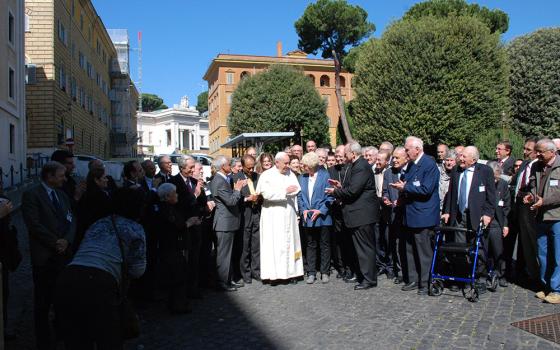
Church at Santa Teresa, lighted up at night (Provided photo)
Ninety years ago, Missionary of the Sacred Heart (MSC) Fr. Maloney was concerned about the impact of white settlement on the local Arrernte people. He sought the help of Frank McGarry, a World War I veteran from Sydney, whom he had met through the St. Vincent de Paul Society. Together with the local Aboriginal people they established Little Flower Mission (later to be renamed Santa Teresa).
Through the church — and later a school — they provided physical and emotional safety for the people. Most of the families became Catholic and joined the parish. It is now home to about 500 people and is a community that welcomes guests from around the world to share its unique culture, language and art. The community boasts a Catholic school, a store, a clinic, aged care services and a day nursery.
I became one of the community's guests after several years of working with Aboriginal and Torres Strait Islander people in Queensland, when I was asked to go to Santa Teresa. At the time it seemed like it was just another step in ministry for me, but it became much more.
Advertisement
Being the parish assistant at Santa Teresa was very different from my previous work as assistant to the principal for religious education at a boarding school for Aboriginal and Torres Strait Islander young men. In my Queensland ministry the students came from numerous communities and cultures, so becoming well acquainted with any particular community's culture was not easy. At Santa Teresa, all the people were of one culture and language, so during these past 11 years I have had the challenge and opportunity to be gifted by the local people as I have learned and lived their language and culture.
The COVID-19 pandemic has made this 500-member community of Eastern Arrernte people one of the most vulnerable to contagious infection because of its size. Contagion could easily wipe out the entire community. Thus, lockdown started March 18. Only essential services (medical staff, police, and the store delivery truck) are permitted to come into the community — and no one else can leave.
It has really affected every family here, especially the women, who have the most responsibility for the family. The economy has been devastated, as day visitors and those coming for immersion experiences of several days are prohibited. Twenty already-scheduled immersion groups and the visits of numerous day visitors have been cancelled.
The imposed isolation has also meant closing the community's Spirituality Centre, normally a hive of activity of artists and visitors and a vital hub for gathering Arrernte women. Here the women share and create their works of art, filling shelves with brightly patterned hand-colored silk scarves, and walls hung with paintings and crosses.
Georgina Furber paints a Santa Teresa Cross (Provided photo)
The crosses are the Arrernte women's response to their Christian faith and cultural beliefs in "Ngkarte" (God). Each cross is unique, hand painted in bright dot designs and colors. The women have been making these crosses since the Spirituality Centre opened more than 10 years ago. Their success exceeded all expectations — 30,000 crosses have been painted in that time. It's a project that is possible because Santa Teresa Parish provides the power, water and the venue, and the women do the rest.
The hand-made crosses have become famous and carried to all corners of the world by visiting tourists and pilgrims. Sales of art and religious objects are a much needed supplement to the women's limited incomes and of course that supplement is now reduced by the lockdown. One of the ladies mourned the loss: "The virus has impacted on us significantly as we have no visitors, so I ask you to keep us and our families in your prayers — the last thing that we want is someone here to get the virus." In spite of this situation, the women are relentlessly productive and continue their work in their homes.

In a communal effort to keep the COVID-19 virus message "out there," a painting competition for families was initiated to turn car bonnets (hoods) into artwork. (Provided photo)
In a communal effort to keep the COVID-19 virus message "out there," a painting competition for families was initiated to turn car bonnets (hoods) into artwork, highlighting important messaging to promote:
- community awareness about COVID-19
- the use of local language for messages
- making the community safe and healthy
- engaging families, enjoying the project and having fun
- beautifying the community with vibrant colors and with traditional art work
- "up-cycling" car bonnets to become community message and information boards.
Throughout Holy Week, people in the community — mindful of social distancing — gathered nightly for gospel singing and family prayer. On the eve of Easter Sunday, the parish priest Father Elmer and I filled containers of water to become Easter water. People came throughout the day and the weekend to take home bottles of water for use during the Family Prayer recited in the home on Easter Sunday.
In another effort to support the community, each night the internal and external lights of the church are turned on to help all of us remember that as dark as these times seem, God is always with us; to trust God who cares for us; to care for each other and pray for all in the community; to say "thank you" to all who are caring for us, especially the staff of the clinic and the store and the police.

Immersion group of visitors at Santa Teresa (Provided photo)

Santa Teresa (Ltyentye Apurte) is a remote community of the Eastern Arrernte Aboriginal People in Central Australia, located southeast of Alice Springs on the edge of the Simpson Desert. (Provided photo)
Some of us wonder if we will ever come out of the "tomb" of isolation from COVID-19 and its preventative measures. Yet we can use these days as a way to challenge perceptions in acts of kindness, compassion and care for one another. This is the faith that pervades the Arrernte women and their families in Santa Teresa, as they design artworks that celebrate Christ's resurrection as the triumph of life over death.
I am often asked, "How do you fit the Arrernte culture and spirituality with your Christian/ Catholic beliefs?" My response on each occasion is similar: As I have come to know and appreciate the 65,000-year-old spirituality of these people, I find a seamless interface with my own spirituality. In fact, my spirituality is richer and deeper because of my greater understanding of the Arrernte people. To be gifted with knowledge and understanding of this very ancient culture is a most sacred experience — one that I hold in wonder every day.
[Liz Wiemers, a Sister of the Good Samaritan of the Order of St. Benedict, has worked with Aboriginal and Torres Strait Islander people in various areas of Australia over the past 40 years, 11 of which have been in Santa Teresa in Central Australia. Presently she is the parish assistant there, with responsibilities that include liturgy, secretarial, and financial matters of the parish. She facilitates some 20 immersion groups in the parish each year, and coordinates the Spirituality Centre and parish accommodation.]








